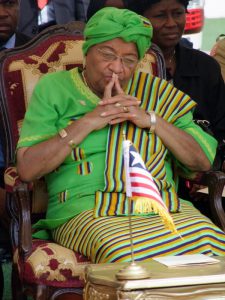
Monrovia: “Water! Water!” Eugene Seoh shouted from his three-story apartment building on Benson Street, a main avenue in the center of Monrovia. From across the road, water vendor Jerry Worlogar looked up and nodded. Seoh hurried down the stairs. He stood before Worlogar’s hand-drawn cart full of white five-gallon containers. “Thirty-five \[Liberian] dollars for one gallon,” Worlogar told Seoh. “Every day your price is changing,” Seoh complained. “That’s dry season,” Worlogar said. “You know the water business is hard.” Water business in Liberia is indeed hard, whatever the season. Like many in central Monrovia, Seoh has to search for water every day. He and his wife Louise, who is seven months pregnant, get up before dawn to trudge up and down three flights of stairs to retrieve water from the building’s well. More than half of Eugene Seoh’s monthly income goes to buying water. While Seoh and many Liberians are searching for safe drinking water, President Ellen Johnson Sirleaf is in Botswana attending the first-ever Summit for Sustainability in Africa. For the next two days, President Sirleaf, along with nine other African leaders, will convene to discuss the sustainable management of natural resources, including strategies for water security. This issue in particular is critical for Liberia. The civil war left us facing an impossible water crisis – not just in outlying areas and slums but in our nation’s capital. And the government’s own statistics are not helping efforts to crack the country’s water problems. Measuring ProgressSeoh’s struggle does not show up in the country’s development reports. The Liberian government submitted information to the World Health Organization and UNICEF Joint Monitoring Program that estimated eight percent of households in urban areas have piped water and 88 percent have access to an improved water source. Living in the heart of Monrovia, Seoh should be one of the few Liberians who do have piped water. He does not.
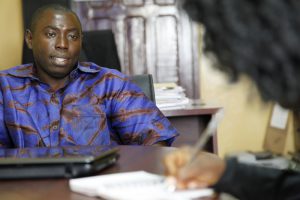
Theophilus Addey, the acting Deputy National Coordinator of the Liberia Reconstruction Development Committee, says the water figures are just a guide for the government. Theophilus Addey, the acting Deputy National Coordinator of the Liberia Reconstruction Development Committee, said these figures are just a guide for the government. “Are they precise?” said Addey. “It’s hard to say. The numbers give us the means to say how much progress has been made.” Not only the numbers are questionable; the government is also making suspect claims about specific water access projects. The Managing Director of the Liberia Water and Sewer Corporation, Nortu Jappah, said in an interview in November that he and President Sirleaf had recently opened a water main to serve the string of neighborhoods along Somalia Drive. The area has not had piped water for more than two decades. Somalia Drive still does not have piped water. In hours of searching following the interview with Jappah, just one tap was located. Its owner said it had run just once since the end of the civil war in 2003 – and that was in the lead-up to the presidential election in October. ‘The Water is Not Safe’
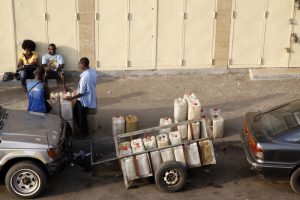
Residents in most parts of the city find it difficult to get clean and safe drinking water [/B] Despite the uncertainty and discrepancies, donors make decisions on how to aid the government based on these statistics. For example, the U.S. Agency for International Development recently approved a grant for water and sanitation in Liberia that included significant funds for sanitation but a smaller allocation for water than in the past. Justifying the distribution, a USAID spokesperson said that “USAID/Liberia’s decision to place an emphasis on sanitation access over water supply access was largely based on the relatively high level of access to improved water supply in Liberia, compared to the very low level of current access to improved sanitation facilities.” Access to sanitation is very low – just 25 percent as of 2008, according to World Bank statistics. Civil society groups in Liberia argue that the current water situation is actually not much improved. Prince Kreplah heads a consortium of organizations working on water and sanitation issues in Liberia and challenged the reliability of the UNICEF Joint Monitoring Program statistics. “I don’t know what you call eight percent having access to pipe water,” said Kreplah. “Is it just running the pipe into someone’s yard and there’s no water in it because the system has broken down?” 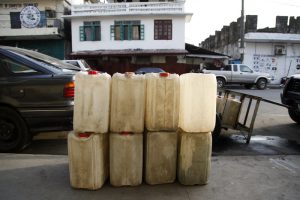 Addey stated pipes are not the only source of safe drinking water. “A hand pump, a hand-dug well may provide safe drinking water based on the treatment,” he said. The government has provided many such hand pumps and wells to communities across the country, according to Addey. But Kreplah said that the majority of these do not supply the quantity of water needed by Liberians. “Most of the wells have run dry; most of the hand pumps have run dry because the water system is no longer working effectively,” said Kreplah. “The country is facing a serious water crisis.” “If you go to clinics and hospitals around our country, you find most of the patients admitted here are people admitted from water-borne and sanitation-related illness,” he said. Seoh buys a bottle of antiseptic solution every week to purify water used for bathing in an attempt to prevent an aggressive rash from attacking his wife’s skin. But this has done little to stop the problem. Seoh took his wife to a hospital, where he said doctors confirmed that the water he buys was the cause of her inflamed skin.
Addey stated pipes are not the only source of safe drinking water. “A hand pump, a hand-dug well may provide safe drinking water based on the treatment,” he said. The government has provided many such hand pumps and wells to communities across the country, according to Addey. But Kreplah said that the majority of these do not supply the quantity of water needed by Liberians. “Most of the wells have run dry; most of the hand pumps have run dry because the water system is no longer working effectively,” said Kreplah. “The country is facing a serious water crisis.” “If you go to clinics and hospitals around our country, you find most of the patients admitted here are people admitted from water-borne and sanitation-related illness,” he said. Seoh buys a bottle of antiseptic solution every week to purify water used for bathing in an attempt to prevent an aggressive rash from attacking his wife’s skin. But this has done little to stop the problem. Seoh took his wife to a hospital, where he said doctors confirmed that the water he buys was the cause of her inflamed skin. 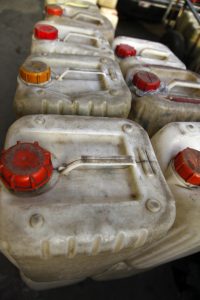 “The water is not safe,” he said. “It’s dirty, very dirty water.” An ‘Overambitious’ Plan In 2008, the Liberian government launched the Poverty Reduction Strategy, or PRS, to chart our nation’s course to development. Among other goals, the plan promised that access to water would double in four years. Since then, little has been done to replace old infrastructure damaged during the civil war, according to Silas Siakor, director of the Sustainable Development Initiative Liberia. “There is absolutely no way that one percent of the people in River Cess or Sinoe or Grand Kru or Maryland or River Gee or Grand Gedeh will have access to pipe-borne water by 2015, not even by 2020. I could bet my head on that,” said 41-year-old Siakor. “People my age in Lofa should not even dream of having pipe-borne water in their lifetime. I am not even going to talk about 2020 or 2030. When leaders make these pronouncements knowing that it is untrue, I’ve got a problem with that.” The government’s own reporting shows failure. By the end of 2011, the government’s final assessment report on the PRS plan showed only seven of 22 goals related to water and sanitation were completed. Only two were of physical projects with direct benefit to the people. The rest were plans and studies. “Under water and sanitation – I’m not talking about the other ones – the PRS failed miserably,” said Kreplah. We said we wanted to do boreholes filtered with hand pumps; we have not developed five percent of the total boreholes under the PRS. Because of lack of resources, they were not delivered. That PRS report is something to be challenged.” Addey conceded that the goals and timeline for water and sanitation were unrealistic. “In some instances, I think we were overambitious,” he said. Kreplah put the blame elsewhere. In the years prior to last October’s presidential election, he said, the government focused on short-term projects for political gain rather than long-term progress on water and sanitation. “We budgeted more for other parts of the development agenda that people see as very tangible and have political dividends, compared to water and sanitation which more political leaders thought were not sexy enough politically to win the attention of people, so as to attract more votes,” said Kreplah. Although financial resources may be in short supply for water and sanitation, rhetorical resources are not. Sirleaf has staked a significant part of her reputation on bringing water to the people of Liberia. She currently serves as the WaterAid goodwill ambassador for water and sanitation to Africa. In August, Sirleaf wrote an editorial in the Washington Post, a top United States newspaper, thanking Americans for their generosity to Liberia and emphasizing her efforts and intentions to increase access to water and sanitation. As the sun set on Benson Street in the heart of Monrovia, Seoh cautiously eyed the containers to be sure he chose one with clean water. He put down a gallon with dark green algae in it and picked up another one that looked better. Regardless of whether this water is safe or purified, Eugene said he is lucky. There are many days that he and his wife cannot even get water to bathe. _____ Tecee Boley in collaboration with New Narratives and the Pulitzer Center on Crisis Reporting; Photos – Gene Seoh; Sumaya Agha; Joanna Devane New Narratives, a project building independent media businesses in Africa, and the Pulitzer Center on Crisis Reporting, an organization sponsoring independent reporting on global issues, provided technical and editorial support for this story. www.newnarratives.org and pulitzercenter.org
“The water is not safe,” he said. “It’s dirty, very dirty water.” An ‘Overambitious’ Plan In 2008, the Liberian government launched the Poverty Reduction Strategy, or PRS, to chart our nation’s course to development. Among other goals, the plan promised that access to water would double in four years. Since then, little has been done to replace old infrastructure damaged during the civil war, according to Silas Siakor, director of the Sustainable Development Initiative Liberia. “There is absolutely no way that one percent of the people in River Cess or Sinoe or Grand Kru or Maryland or River Gee or Grand Gedeh will have access to pipe-borne water by 2015, not even by 2020. I could bet my head on that,” said 41-year-old Siakor. “People my age in Lofa should not even dream of having pipe-borne water in their lifetime. I am not even going to talk about 2020 or 2030. When leaders make these pronouncements knowing that it is untrue, I’ve got a problem with that.” The government’s own reporting shows failure. By the end of 2011, the government’s final assessment report on the PRS plan showed only seven of 22 goals related to water and sanitation were completed. Only two were of physical projects with direct benefit to the people. The rest were plans and studies. “Under water and sanitation – I’m not talking about the other ones – the PRS failed miserably,” said Kreplah. We said we wanted to do boreholes filtered with hand pumps; we have not developed five percent of the total boreholes under the PRS. Because of lack of resources, they were not delivered. That PRS report is something to be challenged.” Addey conceded that the goals and timeline for water and sanitation were unrealistic. “In some instances, I think we were overambitious,” he said. Kreplah put the blame elsewhere. In the years prior to last October’s presidential election, he said, the government focused on short-term projects for political gain rather than long-term progress on water and sanitation. “We budgeted more for other parts of the development agenda that people see as very tangible and have political dividends, compared to water and sanitation which more political leaders thought were not sexy enough politically to win the attention of people, so as to attract more votes,” said Kreplah. Although financial resources may be in short supply for water and sanitation, rhetorical resources are not. Sirleaf has staked a significant part of her reputation on bringing water to the people of Liberia. She currently serves as the WaterAid goodwill ambassador for water and sanitation to Africa. In August, Sirleaf wrote an editorial in the Washington Post, a top United States newspaper, thanking Americans for their generosity to Liberia and emphasizing her efforts and intentions to increase access to water and sanitation. As the sun set on Benson Street in the heart of Monrovia, Seoh cautiously eyed the containers to be sure he chose one with clean water. He put down a gallon with dark green algae in it and picked up another one that looked better. Regardless of whether this water is safe or purified, Eugene said he is lucky. There are many days that he and his wife cannot even get water to bathe. _____ Tecee Boley in collaboration with New Narratives and the Pulitzer Center on Crisis Reporting; Photos – Gene Seoh; Sumaya Agha; Joanna Devane New Narratives, a project building independent media businesses in Africa, and the Pulitzer Center on Crisis Reporting, an organization sponsoring independent reporting on global issues, provided technical and editorial support for this story. www.newnarratives.org and pulitzercenter.org
